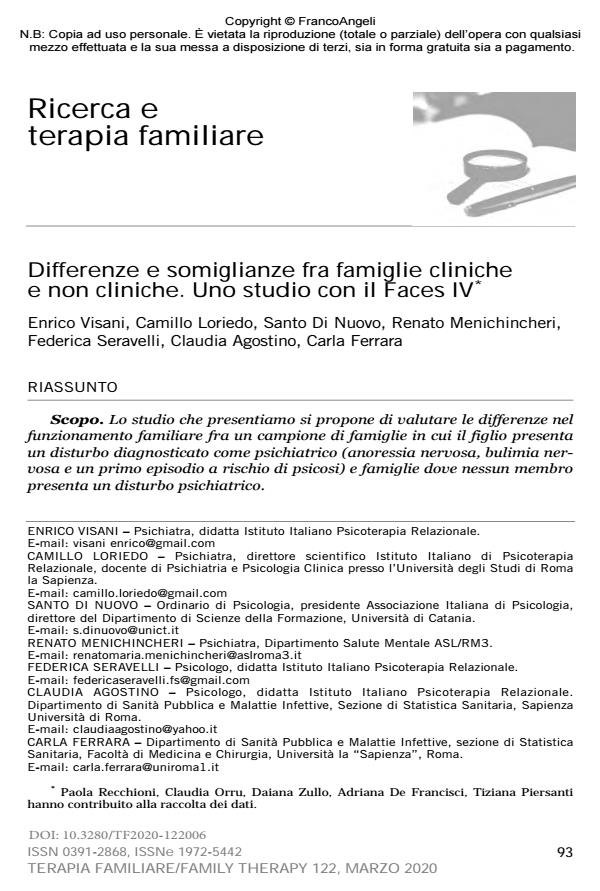Differences and similarities between clinical and non-clinical families. A research with Faces IV
Journal title TERAPIA FAMILIARE
Author/s Enrico Visani, Camillo Loriedo, Santo Di Nuovo, Renato Menichincheri, Federica Seravelli, Claudia Agostino, Carla Ferrara
Publishing Year 2020 Issue 2020/122
Language Italian Pages 18 P. 93-110 File size 213 KB
DOI 10.3280/TF2020-122006
DOI is like a bar code for intellectual property: to have more infomation
click here
Below, you can see the article first page
If you want to buy this article in PDF format, you can do it, following the instructions to buy download credits

FrancoAngeli is member of Publishers International Linking Association, Inc (PILA), a not-for-profit association which run the CrossRef service enabling links to and from online scholarly content.
Purpose. The present study aims to evaluate the differences in family functioning between non-clinical and clinical families samples; in the clinical families sample there is a member with a psychiatric disorder (anorexia nervosa, bulimia nervosa and a first episode at risk of psychosis). Methods. The non-clinical families sample consists of 50 families and the clinical sample of 60 families and for each family unit the data of both parents and a son were collected. The tools used were: a socio-demographic sheet, a clinical sheet for the clinical population and the Faces IV questionnaire validated in the Italian version. The Faces IV questionnaire evaluates family through 8 scales: Balanced cohesion, Balanced flexibility, Disengagement, Enmeshment, Rigidity, Disorganization, Communication and Satisfaction. Results. The comparison between non-clinical and clinical families in Global Family Functioning showed a smaller difference than expected; while values related to parental agreements, family perception by each member and single questionnaire scales values showed statistically significative differences. Conclusions: Clinical and non-clinical families evolutionary pathways follow different ways, even if the differences in global family functioning are less than expected.
Keywords: Faces IV, family research, family therapy, non clinical family, eating disorders, first psychotic disorders.
- American Psychiatric Association (2013). Diagnostic and Statistical Manual of Mental Disorders (Fifth ed.). Arlington, VA: American Psychiatric Publishing (trad. it.: Milano: Raffaello Cortina, 2014).
- Bray J.H., Campbell T.L. (2007). The family’s influence on health. Textbook of Family Medicine. 7th ed. Philadelphia, PA: Saunders Elsevier, pp. 25-26.
- Di Nuovo S.,Visani E., Loriedo C. (2014). Adattamento italiano e standardizzazione del Faces IV. In: Visani E., di Nuovo S., Loriedo C. Il Faces IV. Il modello circonflesso nella clinica e nella ricerca. Milano: FrancoAngeli.
- Fallon I.R. (2003). Family interventions for mental disorders: efficacy and effectiveness. World Psychiatry, 2(1): 20.
- Fisher M., Bushlow M. (2015). Perceptions of family styles by adolescents with eating disorders and their parents. International Journal of Adolescent Medicine and Health, 27(4): 443-449.
- Galician Health Technology (2014). Assessment Clinical practice guideline on the management of depression in adults. In: National Guideline Clearinghouse (NGC).
- Koutra K., Triliva S., Roumeliotaki T., Stefanakis Z., Basta M., Lionis C., Vgontzas A.N. (2014). Family functioning in families of first-episode psychosis patients as compared to chronic mentally ill patients and healthy controls. Psychiatry Research, 219(3): 486-496.
- Laghi F., Baiocco R., Ghezzi E., Cacioppo M. (2012). Family functioning and eating disorders in adolescence. Counseling, 5, 1: 55-69.
- Loriedo C. (2014). Le dimensioni del Modello Circonflesso di Olson e i modelli clinici sistemico-relazionali in Faces IV. Il modello circonflesso di Olson nella Clinica e nella Ricerca di E. Visani, S. Di Nuovo, C. Loriedo. Milano: FrancoAngeli.
- McDaniel S.H., Doherty W.J., Hepworth J. (2014). Medical family therapy and integrated care. American Psychological Association.
- National Collaborating Centre for Mental Health. Bipolar Disorder (2014). The Assessment and Management of Bipolar Disorder in Adults, Children and Young People in Primary and Secondary Care. Leicester UK: The British Psychological Society.
- Norcross J., Beutler L., Levant R.F. (2006). Evidence-Based practices in mental health: Debate and dialogue on the fundamental questions. Washington, DC: US American Psychological Association. DOI: 10.1037/11265-00
- Olson D.H. (2011). Faces IV and the circumplex model: Validation study. Journal of Marital and Family Therapy, 37(1): 64-80.
- Olson D.H. (2000). Circumplex Model of marital and Family System. Journal of Family Therapy, 22: 144-167. DOI: 10.1111/1467-6427.0014
- Olson D.H. (2010). Data Analysis Using Faces IV Scores, disponibile on -- www.facesiv.com.
- Olson D.H., Gorall D.M., Tiesel J.W. (2004). Faces IV package. Minneapolis, MN: Life Innovations.
- Olson D.H., Russell C.S., Sprenkle D.H. (1983). Circumplex model of martial and family systems: VI. Theoretical update. Family Process, 22: 69-83.
- Olson D.H., Sprenkle D.H., Russell C.S. (1979). Circumplex model of marital and family systems: I. Cohesion and adaptability dimensions, family types, and clinical applications. Family Process, 18(1): 3-28.
- Reblin M., Uchino B.N. (2008). Social and emotional support and its implication for health. Current Opinion in Psychiatry, 21(2): 201.
- Scottish Intercollegiate Guidelines Network (SIGN) (2013). Management of schizophrenia. Edinburgh (Scotland): Scottish Intercollegiate Guidelines Network.
- Stratton P. (2016). The Evidence Base of Family Therapy and Systemic practice. Association for family Therapy, UK.
- Tolstoj L. (2017). Anna Karenina. Torino: Einaudi.
- Visani E., di Nuovo S., Loriedo C. (2014). Il Faces IV. Il modello circonflesso nella clinica e nella ricerca, Milano: FrancoAngeli.
- Walsh F. (2008). La resilienza familiare. Milano: Raffaello Cortina.
- Welsh P., Tiffin P.A. (2015). Adolescent family perceptions in the at risk mental state for psychosis. Early Intervention in Psychiatry, 9, 4: 316-323.
Enrico Visani, Camillo Loriedo, Santo Di Nuovo, Renato Menichincheri, Federica Seravelli, Claudia Agostino, Carla Ferrara, Differenze e somiglianze fra famiglie cliniche e non cliniche. Uno studio con il Faces IV in "TERAPIA FAMILIARE" 122/2020, pp 93-110, DOI: 10.3280/TF2020-122006